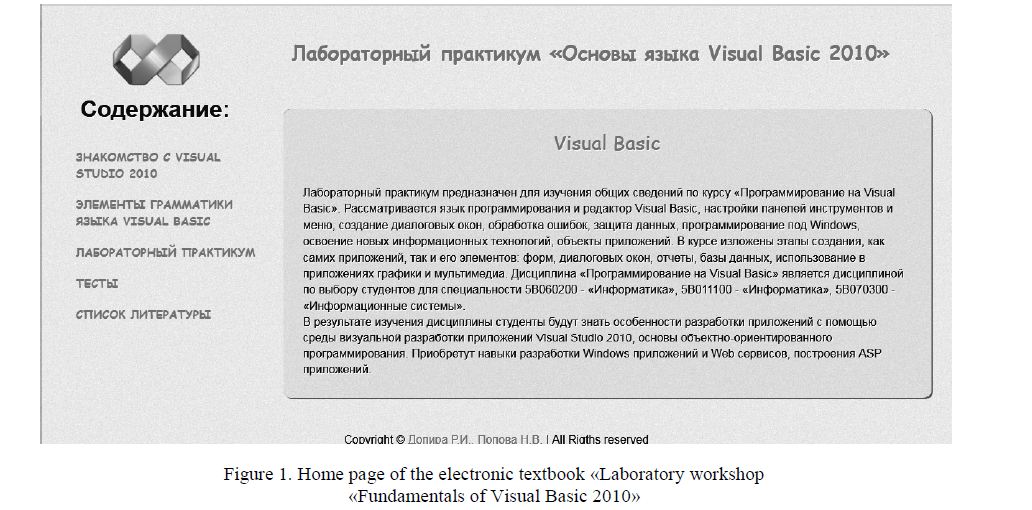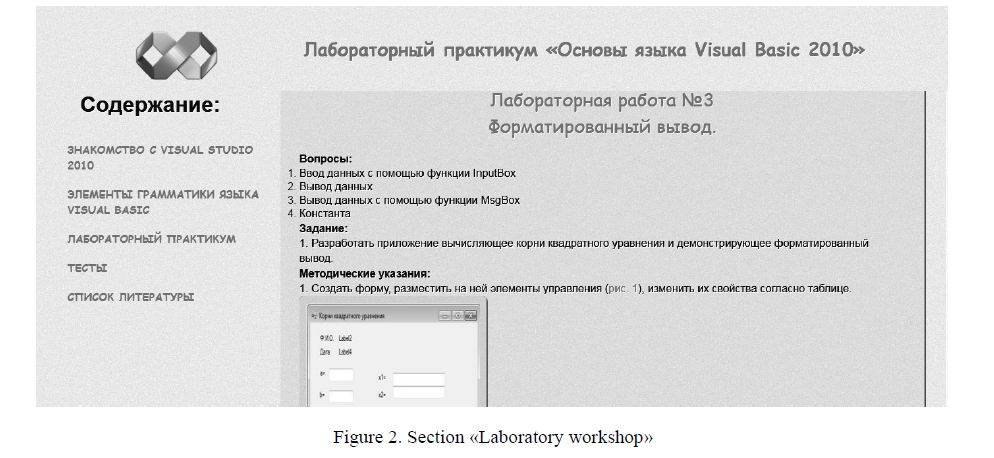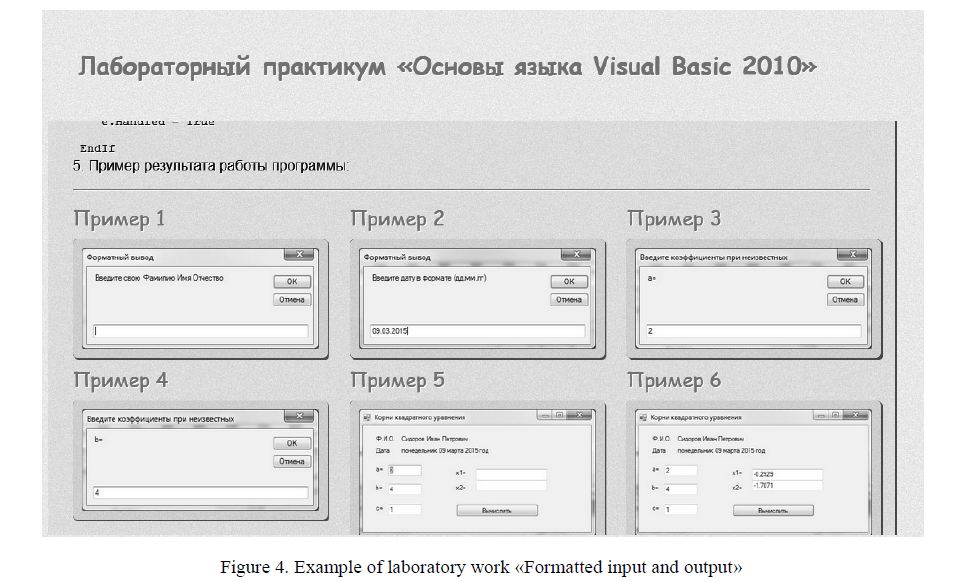The article describes the creation and use in practice of the electronic textbook. It is explored possible means of modern information technologies, the terms of which are required for their successful use is reviewed and analyzed by application soft-ware required to create and further use of electronic textbooks. In addition, we describe all the steps of creating such electronic resources on a specific example of the electronic textbook.
In today's world, the problems of education received much attention due to the fact that the increasing demand for highly skilled and competitive specialists. State Program for Development of Education of the Republic of Kazakhstan for 2011–2020 provides for the access of each of the participants in the educational process to modern educational resources and technologies [1]. The program pays much attention to the creation of conditions for the implementation of the automation of the educational process and the implementation of e-learning at all levels of education. The introduction of e-learning aims to enhance the quality of education, efficiency of education management and information integration with the external environment. For methodological support actively have been developing of disciplines studied at all levels of education, electronic educational resources.
Requirements for electronic educational materials, created for educational institutions of the Republic of Kazakhstan, are defined in State Standard «Information Technology. The electronic publication «[2]. This standard describes the requirements for the design, content, features, background information and feedback developed for training of electronic educational editions.
In this standard, electronic textbook is defined as «an electronic textbook, contains a systematic presentation of the course or section and has the official status of this type of publication that is assigned to a public authority» [2]. Electronic textbook, in it is turn, is designed to automate the process of learning and knowledge control of relevant courses or part of it, to ensure the selection of the trajectory of learning and performing various types of work.
Electronic textbook is usually a set of software, information and methodological tools, which is defined for self-study of an academic subject and typically includes assignments and tests for self-control and testing and can also provide feedback. Electronic textbooks you to browse the contents of the subject under study, to learn the basic concepts to carry out monitoring and evaluation of the knowledge and skills to manage their own learning paths. Electronic books can be used in secondary, technical, vocational, higher and postgraduate levels of education.
Depending on the purpose and functions, requirements and features the use of electronic textbooks, the means of their creation can be divided into groups. In accordance to the criteria proposed the following classification [3]: algorithmic programming languages; general-purpose tools that provide the ability to create an electronic textbook people who are not programmers; multimedia; hypertext tools.
To replenish the information content and improve methodical maintenance of disciplines taught in the Ye.A.Buketov Karaganda State University, there is a need to develop and implement in the educational process a variety of electronic publications.
The main aim of developing the textbook «Laboratory workshop» Basics of Visual Basic 2010» is to support the course with additional teaching materials, ensuring the possibility of self-education, selfmonitoring and individual teaching of» Programming «, the intensification of the traditional educational process through the use of training programs. The objective of this electronic textbook — to help students to acquire practical knowledge in Visual Basic, know the basic concepts of the language and be able to work in Visual Studio 2010 to be able to implement the algorithm of solving problems. Figure 1 shows the main page of the electronic textbook.

Figure 1. Home page of the electronic textbook «Laboratory workshop «Fundamentals of Visual Basic 2010»
In the development of this tutorial have been passed all the stages included in the design methodology of electronic textbooks [3]. Goals and objectives of the development of the electronic textbook were identified, structure was thought and the script component is configured and structured training material was prepared, according to the standard program of undergraduate specialties. After the creation of the electronic textbook «Laboratory workshop» Basics of Visual Basic 2010 «was carried out its testing in order to identify and correct some minor errors, comments on the operation, etc.
The structure of the electronic textbook was developed in the visual HTML-editor, Adobe DreamWeaver CS3. The educational material was presented to software as a set of web-documents incorporated software interface. The boot file is start.html. Home is divided into three frames. The top frame is the name of a textbook and a link to the page with the data of the authors. The bottom frame contains the names of the authors have developed this tutorial. On average, the main frame page is located, consisting in turn of two parts. The left side of the page is a table of contents, and in the right part of the content of selected chapters of the textbook.
Menu contents implemented in the form of hyperlinks. Reference table of contents menu structure allows you to navigate the content of the textbook. Select an item from the list of contents leads to the display in the main part of the relevant section of the page contents. Since the contents are constantly located on the left side of the page, the user may at any time move it to the desired section of the textbook
The content of the electronic textbook includes items: an introduction, two theoretical sections, section of guidelines for laboratory workshops, test items, a list of references. The theoretical material for the study is presented in two sections, which include the basics of working in Visual Studio 2010 and a description of the programming language Visual Basic.
Section: «Introduction to Visual Studio 2010», includes lecture mate-rial paragraphs and exercises for fixing. In this section we consider the topic «Starting the System Visual Studio 2010 and create a project», «UI Design», «The development of the code», «Working with Forms.» This section is intended for the development of an application development environment.
The section «Elements of grammar of the language Visual Basic» consists of three sections. Each section contains the lecture material and exercises to demonstrate the possibility of the programming language. In the lectures the basic operators, instructions, subroutines are analyzer. Material in an accessible and concise manner will allow the student to learn the features of the programming language Visual Basic.Net.
Section «Laboratory workshop», presented in Figure 2, contains 10 laboratory work, the implementation of which will allow to learn the theoretical material and acquire practical skills of programming in Visual Basic in Visual Studio 2010.

Figure 2. Section «Laboratory workshop»
The section «Tests», presented in Figure 3, includes tests on the subjects studied. After answering the questions suggested by the test to count the correct answers. See «References» includes literature for selfstudy.

Figure 3. The section «Tests»
For the purpose of testing an electronic textbook to teachers were encouraged to use the Department of Applied Mathematics and Computer Science of Ye.A.Buketov Karaganda State University leading discipline, which include the study of programming techniques, as well as full-time students and students of the correspondence department discipline module «Programming». Students enrolled in an undergraduate program, including remote, regularly studied theoretical material, pre-representations in the textbook. Mode self-testing and helps verify the knowledge gained in the study of the theoretical and practical course material.
To determine the students' opinions about the electronic textbook developed a questionnaire including 20 questions. The survey was attended by 50 students. Analysis of the results led to the following conclusions:
Electronic textbook is easy to use. This was the opinion of 95 % of the students surveyed, 75 % had never used the help mode;
- an electronic textbook is popular among For about 75 % of the students use the textbook more than four times, and 57 % — more than five times;
- an electronic textbook is useful for students: 70 % of students plan to use this tutorial in the future;
- 51 % of students believe that it is desirable to increase the number of dismantled examples and add the ability to test the responses of exercise and
Electronic textbook «Laboratory workshop» Basics of Visual Basic 2010» is used in the educational process at studying of disciplines of the module» Programming «students of Information Sciences Faculty of Mathematics and Information Technology. The textbook can be used by students as in the classroom and in their free time for individual learning and self-control. Guidelines for laboratory work contain tasks, instructions to performance, exemplary results of the programs and control questions on the topic. Figure 4 shows the results of the programs that the students have to get in the quest of a laboratory practical.
The use of ICT in modern education provides a strong relationship of teaching and information technology training. E-learning materials are actively involved in to modern didactic education system.

Figure 4. Example of laboratory work «Formatted input and output»
Informatization of education in Kazakhstan, one of the main directions of modernization of the educational process and involves the development of a modern methodological training system. The use of electronic educational resources in vocational education provides a strong relationship of teaching and information technology training. Active use of electronic textbooks contributes to the quality of training of specialists and the integration of the national system of education in the world educational space.
References
- State Education Development Programme of the Republic of Kazakhstan for 2011–2020 // http://www.edu.gov.kz/ru/zakonodatelstvo/ gosudarstvennaja_programma_razvitija_obrazovanija/gosudarstvennaja_programma_razvitija_obrazovanija_respubliki_kazakhstan_ na_2011_2020_gody/
- State Standard of the Republic of Kazakhstan «Information Technology. Electronic edition» № 1 of 26 January 2005 http://www.kaznu.kz/content/files/pages/folder486/goso2005.pdf
- Yakovenko V., Pustovalov I.V. Overview of the requirements to build an electronic textbook // http://uchebilka.ru/informatika/4704/ index.html